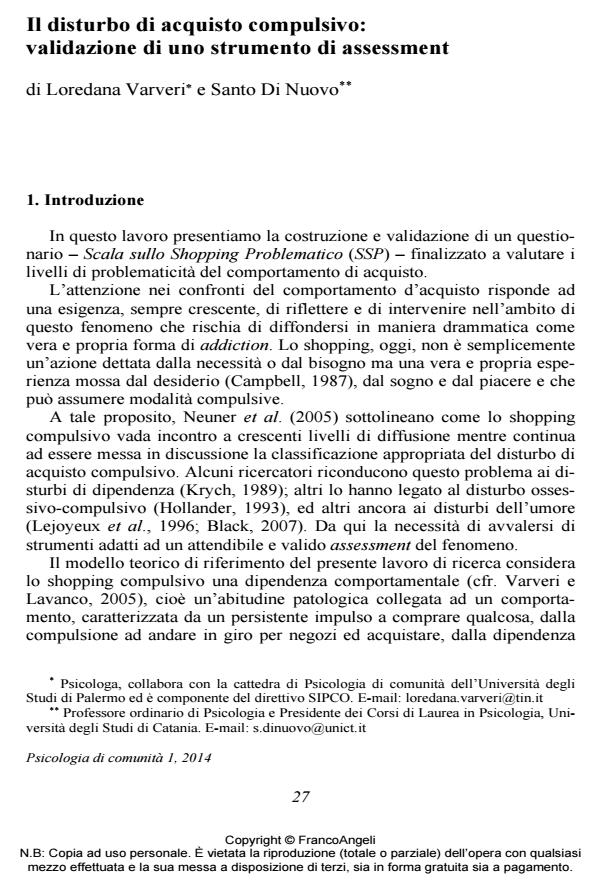Il disturbo di acquisto compulsivo: validazione di uno strumento di assessment
Titolo Rivista PSICOLOGIA DI COMUNITA’
Autori/Curatori Loredana Varveri, Santo Di Nuovo
Anno di pubblicazione 2014 Fascicolo 2014/1 Lingua Italiano
Numero pagine 19 P. 27-45 Dimensione file 110 KB
DOI 10.3280/PSC2014-001003
Il DOI è il codice a barre della proprietà intellettuale: per saperne di più
clicca qui
Qui sotto puoi vedere in anteprima la prima pagina di questo articolo.
Se questo articolo ti interessa, lo puoi acquistare (e scaricare in formato pdf) seguendo le facili indicazioni per acquistare il download credit. Acquista Download Credits per scaricare questo Articolo in formato PDF

FrancoAngeli è membro della Publishers International Linking Association, Inc (PILA)associazione indipendente e non profit per facilitare (attraverso i servizi tecnologici implementati da CrossRef.org) l’accesso degli studiosi ai contenuti digitali nelle pubblicazioni professionali e scientifiche
L’articolo presenta la costruzione e i risultati della validazione di un questionario, la Scala di Shopping Problematico (SSP), ideato per la valutazione del comportamento d’acquisto irregolare. La scala, composta nella versione finale da 22 item, ha dimostrato buona consistenza interna. L’analisi fattoriale consente di individuare due dimensioni principali che spiegano il 44.84% della varianza totale. Lo studio dell’affidabilità e della validità concorrente hanno evidenziato risultati pienamente soddisfacenti per cui la SSP può essere considerata, dal punto di vista psicometrico, uno strumento valido per la valutazione del comportamento d’acquisto irregolare. È, inoltre, di facile somministrazione e non richiede un training specifico; si configura perciò utile per ricerche epidemiologiche e all’interno di una procedura di screening alla quale far seguire una fase di approfondimento.;
Keywords:Shopping compulsivo, dipendenza, valutazione, attendibilità, validazione, Scala di Shopping Problematico.
- Black D. (2007). A Review of Compulsive Buying Disorder. World Psychiatry, 6: 14-18, testo disponibile al sito: http://www.ncbi.nlm.nih.gov/pmc/articles/PMC1805733/.
- Biolcati R. and Melotti G. (2013). Contribution to the internal validation of the Italian version of the Compulsive Buying Scale (Valance, d’Astous and Fortier, 1988). Bollettino di Psicologia Applicata, 266: 13-21.
- Campbell C. (1987). The Romantic Ethic and the Spirit of Modern Consumerism. Oxford: Basil Blackwell (trad. it.: L’etica romantica e lo spirito del consumismo moderno. Roma: Lavoro, 1992).
- Christenson G.A., Faber R.J., de Zwaan M., Raymond N.C., Specker S.M., Ekern M.D., Mackenzie T.B., Crosby R.D., Crow S.J. and Eckert E.D. (1994). Compulsive buying: descriptive characteristics and psychiatric comorbility. Journal of Clinical psychiatry, 55: 5-11.
- DeSarbo W.S. and Edwards E.A. (1996). Typologies of compulsive buying behavior: a constrained clusterwise regression approach. Journal of Consumer Psychology, 5: 231-252. DOI: 10.1207/s15327663jcp0503_0
- Dittmar H. (2005). Compulsive buying - A growing concern? An examination of gender, age, and endorsement of materialistic values as predictors. British Journal of Psychology, 96 (4): 467-491. DOI: 10.1348/000712605X53533
- Dittmar H. (2004). Understanding and diagnosing compulsive buying. In: Coombs R., editor, Handbook of Addictive disorders: a practical Guide to Diagnosis and Treatment. New York: Wiley, cap. 13, pp. 438-472.
- Edwards E.A. (1993). Development of a new scale to measure compulsive buying behavior. Financial Counseling and Planning, 4: 67-84, testo disponibile sul sito https://afcpe.org/assets/pdf/vol-45.pdf.
- Elliott R. (1994). Addictive Consumption: Function and Fragmentation in Postmodernity. Journal of Consumer Policy, 17: 159-179.
- Faber R.J. and O’Guinn T.C. (1992). A clinical screener for compulsive buying. Journal of Consumer Research, 19: 459-469. DOI: 10.1086/20931
- Friese S. (2000). Self-concept and identity in a consumer society: aspects of symbolic product meaning. Marburg: Tectum.
- Frost R.O., Kim H., Morris C., Bloss C., Murray-Close M. and Steketee G. (1998). Hoarding, compulsive buying and reasons for saving. Behaviour Research and Therapy, 36: 657-664. DOI: 10.1016/S0005-7967(98)00056-4
- García I. (2007). Addictive Buying: Causes, Processes, and Symbolic Meanings. Thematic Analysis of a Buying Addict’s Diary. The Spanish Journal of Psychology, 10, 2: 408-422, testo disponibile al sito: http://revistas.ucm.es/index.php/SJOP/article/view/SJOP0707220408A.dom House. Goodman W.K., Price L.H., Rasmussen S.A., Mazure C., Fleischman R.L. and Hill
- C.L. (1989). The Yale-Brown Obsessive Compulsive Scale (Y-BOCS), part I: development, use, and reliability. Archives of General Psychiatry, 46: 1006-1011.
- Goodman W.K., Price L.H., Rasmussen S.A., Mazure C., Delgado P. and Heninger
- G.R. (1989). The Yale-Brown Obsessive Compulsive Scale (Y-BOCS), part II: validity. Archives of General Psychiatry, 46: 1012-1016.
- Krych R. (1989). Abnormal consumer behavior: a model of addictive behaviors. Advances in Consumer Research, 16: 745-748.
- Hollander E., editor (1993). Obsessive-compulsive related disorders. Washington: American Psychiatric Press.
- Isen A.M. (1984). The influence of positive affect on decision making and cognitive organization. Advances in Consumer Research, 11: 534-537, testo disponibile al sito: http://www.acrwebsite.org/search/view-conference-proceedings.aspx?Id=6302.
- Lejoyeux M., Andes J., Tassian V. and Solomon J. (1996). Phenomenology and psychopathology of uncontrolled buying. The American Journal of Psychiatry, 153: 1524-1539.
- Monahan P., Black D.W. and Gabel J. (1996). Reliability and validity of a scale to measure change in persons with compulsive buying. Psychiatry Research, 64: 59-67. DOI: 10.1016/0165-1781(96)02908-3
- Neuner N., Raab G. and Reisch L.A. (2005). Compulsive buying in maturing consumer societies: An empirical re-inquiry. Journal of Economic Psychology, 26: 509-522. DOI: 10.1016/j.joep.2004.08.002
- Pani R. e Biolcati R. (1998). Shopping compulsivo. Urbino: QuattroVenti.
- Schwartz S.H. (1992). Universals in the content and structure of values: Theory and empirical tests in 20 countries. In: Zanna M., editor, Advances in experimental social psychology. New York: Academic Press, cap. 1, pp. 1-65.
- Scherhorn G., Reisch L.A. and Raab G. (1990). Addictive buying in West Germany: An empirical study. Journal of Consumer Policy, 13: 355-387.
- Valence G., d’Astous A. and Fortier L. (1988). Compulsive buying: concept and measurement. Journal of Consumer Policy, 11: 419-433.
- Villarino R.R., González-Lorenzo M., Fernández-González Á., Lameiras-
- Fernández M. and Foltz M.L. (2006). Individual factors associated with buying addiction: An empirical study. Addiction Research and Theory, 14 (5): 511-525.
- Villarino R.R., Otero-López J.M. and Castro R.R. (2001). Addictión a la Compra. Madrid: Pirámid.
Loredana Varveri, Santo Di Nuovo, Il disturbo di acquisto compulsivo: validazione di uno strumento di assessment in "PSICOLOGIA DI COMUNITA’" 1/2014, pp 27-45, DOI: 10.3280/PSC2014-001003